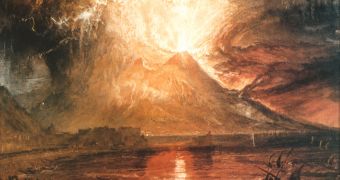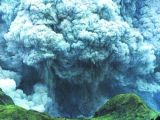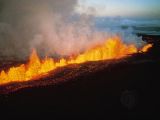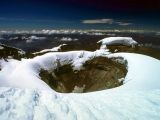Volcanoes are the result of the tectonic movements of the Earth's crust, when magma from the entrails of the planet goes out as lava. They became present in the legends and mythology of all people living around them, which venerated and feared them at the same time.
There are submarine and terrestrial volcanoes, but those with an impact in human life are mostly terrestrial. These are encountered on the subduction zones (where a tectonic plaque falls under another) like on the Pacific Ring of Fire (from Kamchatka till Indonesia and western Americas, from Alaska to Chile) or on the oceanic mid-ridges (like in Iceland).
Amongst the hundreds of active or non-active volcanoes, here is a list that most people should know, about the most significant volcanoes on Earth. They are not aligned by size or importance.
The most important volcano in North America is Mount Saint Helens, located in Skamania County, Washington, in the Pacific Northwest region of the US, at 96 miles (154 km) south of the city of Seattle and 53 miles (85 km) northeast of Portland, Oregon. This active volcano is located in the Cascade Range and is part of the Cascade Volcanic Arc, a segment of the Pacific Ring of Fire that includes over 160 active volcanoes. On May 18, 1980, its eruption, the deadliest and most economically destructive volcanic event in the history of the US, killed 57 people, even if it is considered minor when compared to others elsewhere on Earth.
Popocat?petl ("Smoking Mountain" in the language of the Aztecs) is the most important volcano in Central America. This volcano had over 20 major eruptions since the arrival of the Spanish in 1519. It is only 70 km southeast of Mexico City, and even if still active, it is covered by glaciers.
The most famous volcano of South America is Cotopaxi, located in the Andes, about 75 km (50 mi) south of Ecuador's capital, Quito, one of the highest active volcanoes in the world. It is the second highest in Ecuador, after Chimborazo (which is an inactive volcano). Cotopaxi rises from a highland plain of about 3,800 meters (12,500 ft), and has glaciers, even if located on the Equator, starting from 5,000 meters high (16,400 ft). There have been more than 50 eruptions of Cotopaxi since 1738, the last one in 1904.
During a war between the Incas and the Spaniards in 1534, the volcano erupted and put an end to the fighting as both fled from the battlefield. In the 1877 eruption pyroclastic flows descended all sides of the mountain, with lahars traveling more than 100 km into the Pacific Ocean and western Amazon basin draining the valley. The main danger of a huge eruption of Cotopaxi would be the flow of ice from its glacier and could affect 100,000 people and another eruption is imminent.
Ojos del Salado (6,900-6,905 m) is a volcano located in the Andes on the Argentina-Chile border. It is the highest historically active volcano on earth, located in a remote and very dry region.
Mount Pel?e (French:"Bald Mountain") is the most famous and active volcano in the Caribbean, located on the French Martinique island. Its eruption, in 1902, caused the worst volcanic disaster of the 20th Century, destroying the city of Saint-Pierre and killing about 26,000 to 36,000 people. This blast brought to the attention of the public and governments the hazards and dangers of an active volcano. Mount Pel?e could reawaken at any time.
There are 32 volcanoes in Iceland that have erupted in the historical times.
Surtsey (Icelandic: "Surtur's island") is the most known, as it formed a volcanic island off the southern coast of Iceland after an eruption that began 130 meters below sea level, and reached the surface on November 14, 1963. The eruption lasted until June 5, 1967, when the island reached its maximum size of 2.7 km?, but since then, it has been eroded by wind and waves to only 1.4 km? in size (with a rhythm of 10,000 square km yearly). Today the island harbors birds and seals colonies and in 2001, the Icelandic government submitted the island to be listed as a UNESCO World Heritage Site.
Europe's most known volcanoes are, of course, Mount Vesuvius and Etna.
Mount Vesuvius (1,281 m) is located 9 km (6 mi) east of Naples, Italy. It is the only volcano on the European mainland to have erupted within the last hundred years. It is best known for its eruption in AD 79 that led to the destruction of the Roman cities of Pompeii and Herculaneum. It has erupted many times since and today is regarded as one of the most dangerous volcanoes in the world because of the 3,000,000 people now living close to it and its tendency towards explosive eruptions.
Vesuvius was formed as a result of the collision of two tectonic plates, the African and the Eurasian. The former was pushed beneath the latter, deeper into the earth. Since 79, the volcano has erupted over 50 times, the last time in 1944, and none of the post-79 eruptions were as large or destructive as it. On occasions, the eruptions have been so large that the whole of southern Europe has been blanketed by ashes; in 472 and 1631, Vesuvian ashes fell on Constantinople (Istanbul), over 1,200 km away.
Mount Etna (from the Greek word aitho "to violently burn") is an active volcano on the east coast of Sicily, close to Messina and Catania. It is the largest active volcano in Europe, currently standing about 3,326 m (10,910 ft) high. Mount Etna is one of the most active volcanoes in the world and it is in an almost constant state of eruption. Its most destructive eruption during this time occurred in March 1669, when an estimated 830,000,000 m? of lava was ejected. The latest major eruption occurred on 2001 and the most recent in April, 2007.
In the western Pacific Ring of Fire, the most known volcanoes are Pinatubo and Krakatoa.
Krakatoa is a volcano located on an island in the Sunda Strait between Java and Sumatra in Indonesia. The best known eruption culminated in a series of massive explosions on August 26-27, 1883, which generated the loudest sound historically reported: it was distinctly heard as far away as Perth in Australia (approx. 1930 miles or 3100 km), and the island of Rodrigues near Mauritius (approx. 3000 miles or 4800 km). Atmospheric shock waves reverberated around the world seven times and were detectable for five days. 36,417 were killed, mostly by the tsunamis which followed the explosion.
The eruption destroyed two thirds of the island of Krakatoa and eruptions of the volcano since 1927 have built a new island in the same location, called Anak Krakatau (child of Krakatoa). In the year following the eruption, average global temperatures fell by as much as 1.2 degrees Celsius. Weather patterns continued to be chaotic for years, and temperatures did not return to normal until 1888.
The 1883 eruption of Krakatoa is among the most violent volcanic events in modern times, equivalent to 200 megatons of TNT, about 13000 times the yield of the Little Boy bomb which devastated Hiroshima, Japan. Concussive air waves from the explosions traveled seven times around the world, and the sky was darkened for days afterwards.
Sea waves caused by the eruption were recorded as far away as the English Channel. The island is still active, with its most recent eruptive episode having begun in 1994.
The islands have turned a major case study of island biogeography and founder populations in an ecosystem being built from the ground up in an environment virtually sterilized.
Mount Pinatubo is an active stratovolcano located on the island of Luzon (Philippines). Before 1991, the mountain was inconspicuous and heavily eroded, covered by dense forests which supported a population of several thousand indigenous people, the Aeta, who had fled to the mountains from the lowlands when the Spanish conquered the Philippines in 1565.
The volcano's eruption in June 1991 came after 635 years of dormancy, and produced the second largest terrestrial eruption of the 20th century. The effects of the eruption were felt worldwide. It ejected roughly 10 billion metric tons of magma, and 20 million tons of SO2, bringing vast quantities of minerals and metals to the surface environment. It injected large amounts of aerosols into the stratosphere-more than any eruption since that of Krakatoa in 1883. Global temperatures dropped by about 0.5?C (0.9?F), and ozone destruction increased substantially.
In Oceania, the most famous volcano is Mauna Loa ("Long Mountain") from the Island of Hawaii. It is Earth's largest volcano, with a volume estimated at approximately 18,000 cubic miles (75,000 km?), although its peak is about 36 m (120 ft) lower than that of its neighbor, Mauna Kea. Lava eruptions from Mauna Loa are very fluid and the volcano has extremely shallow slopes as a result. The volcano has probably been erupting for at least 700,000 years and may have emerged from the sea about 400,000 years ago, although the oldest known dated rocks do not extend beyond 200,000 years. Mauna Loa's most recent eruption lasted from March 24, 1984 to April 15, 1984.
Beside these volcanoes, there are three non active ones with a great impact on human culture. Mount Ararat (5,165 m) is the tallest peak in Turkey. The snow-capped, dormant volcanic cone is located 16 km west of the Iranian and 32 km south of the Armenian border and is the place were Abrahamic religions say Noah landed after the flood. The last activity on the mountain was a major earthquake in July 1840 centered on the Ahora Gorge, a northeast trending chasm that drops 1,825 meters (6,000 ft) from the top of the mountain.
Kilimanjaro (5,895 m) located north-east, is a dormant volcano representing the tallest free-standing mountain rise in the world, 4600 meters (15,000 ft) from the base, and Africa's tallest height. There are fears the volcano may collapse, causing a major eruption similar to the 1980 eruption of Mount St. Helens. The mountain is covered by an ice cap, harboring some of the few equatorial glaciers.
Mount Fuji (3,776 m) is the highest mountain in Japan, located near the Pacific coast of central Honsh?. Mount Fuji is a well-known symbol of Japan and is frequently depicted in art and photographs, as well as visited by sightseers and climbers. The volcano is still considered active, but eruption risk is low, and the last recorded eruption occurred in 1708.

 14 DAY TRIAL //
14 DAY TRIAL // 


